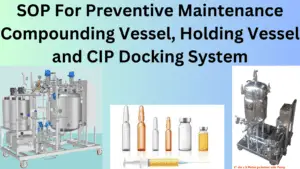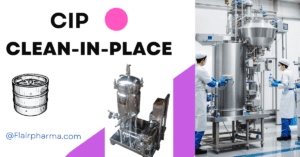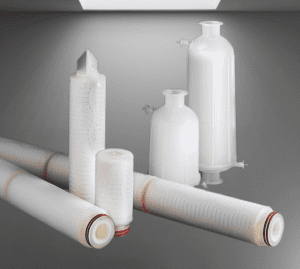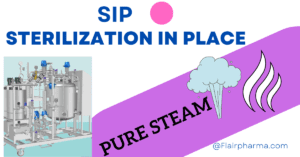The purpose of this (Standard Operating Procedure) SOP For Preventive Maintenance Compounding Vessel, Holding Vessel and CIP Docking System is to outline the steps and guidelines for performing preventive maintenance on the Compounding Vessel, Holding Vessel, and CIP (Clean-in-Place) Docking System to ensure their optimal performance, reliability, and adherence to hygiene standards.
SOP For Preventive Maintenance Compounding Vessel, Holding Vessel and CIP Docking System
- OBJECTIVE:
- This SOP is describing the Preventive Maintenance of Compounding Vessel, Holding Vessel and CIP Docking System.
- SCOPE:
- This SOP is applicable for Preventive Maintenance of Compounding Vessel, Holding Vessel and CIP Docking System installed in Production area.
- RESPONSIBILITY:
- Technician/ Operator shall be responsible for proper execution of preventive maintenance as per SOP.
- Engineering – Head shall be responsible for reviewing the SOP and for ensuring proper execution of preventive maintenance.
- ACCOUNTABILITY:
- Engineering – Head shall be accountable for proper implementation of the SOP.
- DEFINITIONS:
- Nil
- PROCEDURE:
- Preventive maintenance shall be executed as per the SOP No.: SOP/EN/XXXYYY – Execution of Preventive Maintenance.
- Ensure that the spare parts are available at the time of preventive maintenance.
- Checking of pneumatic tubes and fittings
- Physically check the pneumatic tubes and connectors for any damaged/leakage., if any damaged/leak is observed, replace the tube/connector.
- Checking shall be done monthly.
- Checking of leakages.
- Check for any leakage of WFI from pipefitting and connectors. If any leakage is observed, check O-rings, gaskets and replace if found damaged OR worn out.
- Check all the clamps and tighten them if required.
- Check the leakages from WFI recirculation pumps at its inlet and outlet port, if any leakage is observed arrest the same by providing new gasket and tightening the line connectors.
- Checking shall be done monthly.
- Checking of vessels.
- Check and visually inspect the vessel for any damage, dents, surface finish.
- Check the tank accessories for proper installation; check the end connection and wiring contacts if required tight the same.
- Check all the clamps and tighten them if required.
- Checking shall be done six monthly.
- Cleaning Filters cartridge
- Check the reading of differential pressure gauges; if it filters get choked and not giving uniform flow; then the cleaning of cartridge filter is necessary.
- To clean the cartridge filter follows the following procedure.
- Close the inlet and outlet valves of filter.
- Open the drain plug, and drain out the hold water form filter housing; through close drain piping.
- Loose the body flange of cartridge filter housing.
- Remove the cartridge filter; check the condition of filter; if it is found damaged; then replace the same or clean the cartridge filter thoroughly and check for the integrity testing as per SOP No. SOP/PR/XXXYYY.
- Frequency of checking and replacement of filter cartridge shall be as needed.
- Checking of filter housing
- Check the micron filter housing for any dents; leakages; internal finishes.
- Check the filter locking nut threading.
- Checking of frequency shall be quarterly.
- Checking of vent filter
- Physically check the vent filter housing for the roughness, crashes, cleanliness, damaged, dent and rusting, if found clean thoroughly and rectify the same.
- The vent filter replacement and integrity testing should be carried out as per “Procedure for Cleaning and Operation of Filter Integrity Test Instrument” SOP No.: SOP/PR/XXXYYY
- Checking of instruments.
- Check the instruments for proper installation, end connection and wiring connection if required tight the same.
- Checking shall be done after every six month
- Checking of pumps
- Check the pump for any abnormal noise if found, Disconnect the pump motor wiring.
- Disconnect the pump from the pipeline and open the pump.
- Check the condition of bearings, mechanical seal, shaft, impeller and replace if found damaged.
- Checking of the pumps shall be done six monthly
- Checking of Diaphragm Valve
- Check the valve for smoothly movements, if the operating hand wheel of valve is found jammed or stuck, then open the valve and carry out the maintenance as follows.
- Switch off the pump.
- Close the nearby upside and down side valves.
- Open the TC ends, loose the diaphragm valves nut by the Allen key, check the valve for damaged diaphragm, clean the valves, and check for the locking nut of diaphragm.
- If gasket found damaged (cut, leached, deform, shape and size change) change the diaphragm.
- After physically checking of diaphragm valve, refit in to the system and check for leakage and valve operation if found satisfactorily then it is okay otherwise replace the valve.
- For actuated diaphragm valve check for the performance of actuator for valve opening and closing as per interlocks of the system
- Checking of diaphragm valves shall be done after every month.
- Checking of magnetic stirrer
- Check the condition of blades / impellers for fouling; if required clean the same.
- Check the condition of male and female bearing seal.
- Check for abnormal sounds.
- Checking shall be done every month.
- Checking of Filter housing
- Physically verify the filter housing for any damaged, shape change, dents; surface roughness and end connections. If found, then rectify or replace the same
- Checking of filter housing shall be done after very six month.
- Preventive Maintenance – Electrical
- Checking of terminals and wiring
- Ensure that the main electrical supply to the machine is switched OFF.
- Visually check all the power & control wiring, terminals in the electrical panel and control elements mounted on the machine for any loose connection and tight them. If required.
- Check and ensure by using the screwdriver that all the wires are properly tightened at the distribution terminals inside the electrical panel and on the terminals of all the control elements.
- Checking shall be done six monthly.
- Checking of contactors
- Switch OFF the Electrical supply to the Machine.
- Remove all the power and control wires from the contactor terminals.
- Remove the dust from control panel with help of air blower.
- Remove the contactor from the panel and visually check all the contacts for the signs of pitting and deposit of carbon on the contacts.
- Clean the contacts, terminals and all the moving parts of the contactor by spraying contactor cleaner.
- Replace the contacts if found damaged / welded.
- Put back the contactor in the panel and re-terminate all the power and control wires properly to their original locations.
- Check the earthing of the panel body.
- A good earthing shall show less than 2 Volts between the Neutral Wire of the Incoming Power supply and Panel Body.
- Checking of contactors shall be done six monthly.
- Checking of PLC
- Check the PLC for blinking of LED.
- Check the display
- Check the wiring contacts, if required tight the same.
- Checking of PLC shall be done after every six month.
- Checking of motor
- Check the insulation resistance of motor winding with the help of megger.
- Check the phase continuity and winding continuity of motor with the help of tong tester.
- Physically check the motor terminal box and terminal connections.
- Check the voltage drawn by motor with the help of multimeter
- Check the current drawn by motor with the help of tong tester.
- Physically check the direction of rotation; it should be as per recommended direction.
- Check the earthing connections of the motor.
- Checking shall be done after every six month.
- Post Preventive Maintenance – Check List
- Record the PM details as per the Format No.: SOP/EN/XXXYYY “Preventive Maintenance Checklist & Record for Compounding Vessel; Holding Vessel and CIP Docking System”.
- Whenever any modifications and major works are carried out to the equipment, the same shall be mentioned in the equipment history card as per the respective SOP.
- Connect the equipment main power supply and start the equipment.
- Ensure that the equipment is running smoothly, without any abnormality.
- If any abnormality is observed in the above, same will be attended in co-ordination with User department Head.
- ABBREVIATIONS
- CRF No. : Change Request Form number
- QA : Quality Assurance
- PLC : Programmable Logical Controller
- LED : Light Emitting Diode
- REFERENCES
- Nil
- DISTRIBUTION LIST
- SOP shall be distributed to following departments Quality Assurance, Engineering as per user request
- ANNEXURES
- Preventive maintenance checklist and record for Compounding Vessel; : SOP/EN/XXXYYY
- Holding Vessel and CIP Docking System
PREVENTIVE MAINTENANCE CHECKLIST & RECORD FOR COMPOUNDING VESSEL; HOLDING VESSEL AND CIP DOCKING SYSTEM
| Equipment Name | Location | ||
| Equipment ID | Frequency |
| Things to be done: | Check List | Remarks |
| Monthly Check List | ||
| Checking of pneumatic tubes and fittings. | ||
| Checking of piping and leakages. | ||
| Checking of lubrication of bearings; chains; gears and sprockets. | ||
| Checking of diaphragm valves. | ||
| Checking of filter housing. | ||
| Quarterly Check List | ||
| Checking of recycled water circulation pump | ||
| Half Yearly Check List | ||
| Checking of vessels for any damage; dents; insulation; cladding and internal surface finish. | ||
| Checking of tank accessories for proper installation; check he end connection and wiring contacts if required tight he same. | ||
| Checking of filter housings. | ||
| Checking of pumps | ||
| Checking of terminal and wiring | ||
| Checking of motor. | ||
| Checking of PLC. | ||
| Checking of contactors. |
Frequently Asked Questions SOP For Preventive Maintenance Compounding Vessel, Holding Vessel and CIP Docking System.
What is the purpose of the SOP For Preventive Maintenance Compounding Vessel, Holding Vessel and CIP Docking System?
Answer: The purpose of this SOP is to outline the steps and guidelines for performing preventive maintenance on the Compounding Vessel, Holding Vessel, and CIP Docking System to ensure their optimal performance, reliability, and adherence to hygiene standards.
Who is responsible for carrying out the preventive maintenance activities as per the SOP For Preventive Maintenance Compounding Vessel, Holding Vessel and CIP Docking System?
Answer: The maintenance team is responsible for carrying out the preventive maintenance activities as per the SOP.
How often should preventive maintenance be performed on the Compounding Vessel, Holding Vessel, and CIP Docking System?
Answer: Preventive maintenance should be performed at regular intervals:
- Daily: Visual inspection, cleaning, and basic checks.
- Weekly: Lubrication, more thorough checks, and CIP system integrity verification.
- Monthly: In-depth inspection and calibration, if required.
What materials and tools are required for the preventive maintenance of these vessels and the CIP docking system?
Answer: The materials and tools required for preventive maintenance include:
- Clean lint-free cloths
- Approved cleaning solutions and disinfectants
- Lubricants as specified by the equipment manufacturer
- Calibration equipment (as needed)
What are the tasks involved in daily maintenance in the SOP For Preventive Maintenance Compounding Vessel, Holding Vessel and CIP Docking System?
Answer: Daily maintenance tasks include:
- Visual inspection and cleaning of the exterior surfaces.
- Checking the level indicators and valve seals.
- Verifying safety features such as pressure relief valves.
What should be done during weekly maintenance of the vessels and the CIP docking system?
Answer: Weekly maintenance tasks include:
- Thoroughly cleaning the interior surfaces of the vessels.
- Lubricating moving parts and conducting a check of the CIP docking system.
- Verifying the integrity of the CIP system for effective cleaning.
What documentation should be maintained during preventive maintenance?
Answer: Documentation to be maintained includes:
- Maintenance log with date, time, tasks performed, and issues resolved.
- Records of spare parts used and their serial numbers, if applicable.
- Calibration results, if performed.
What safety precautions should be followed in SOP For Preventive Maintenance Compounding Vessel, Holding Vessel and CIP Docking System?
Answer: Safety precautions include:
- Following proper lockout/tagout procedures before maintenance.
- Using appropriate personal protective equipment (PPE) during cleaning and maintenance tasks.
- Adhering to established safety guidelines for handling chemicals and cleaning agents.
- Complying with all safety procedures specified by the company and the equipment manufacturer.
Who should be trained on this SOP?
Answer: All personnel involved in operating, maintaining, or troubleshooting the Compounding Vessel, Holding Vessel, and CIP Docking System should be appropriately trained on this SOP and related procedures.
You may also read about Good Laboratory Practices (GLP)



